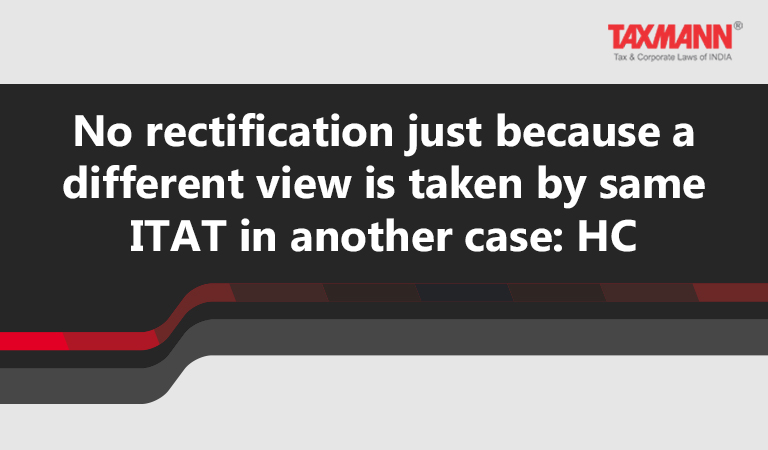No rectification just because a different view is taken by same ITAT in another case: HC
- Blog|News|Income Tax|
- 2 Min Read
- By Taxmann
- |
- Last Updated on 10 August, 2021
Case details: P.T. Manuel & Sons v. CIT - [2021] 129 taxmann.com 4 (Kerala)
Judiciary and Counsel Details
-
- S.V. Bhatti and Bechu Kurian Thomas, JJ.
- Bobby John, Adv. for the Appellant.
- George K. George, Adv. and P.K. Raveendranatha Menon, Sr. Counsel for the Respondent.
Facts of the Case
Assessee filed return of income. Due to delay in filing return of income, Assessing Officer (AO) imposed a penalty under Section 271(1)(a). On appeal, CIT(A) directed AO to determine the quantum of penalty in the light of the directions given by ITAT (Indore Bench) in the case of Ramlal Chiranjilal v. ITO [1992] 107 Taxation 1 (Indore – Trib.). On revenue’s appeal, ITAT confirmed the order passed by CIT(A).
Department filed a petition for rectification of the order passed by ITAT. Department contended that ITAT, in the case of assessee’s sister concern, decided not to follow the case of Ramlal Chiranjilal. Thus, the department submitted that this case was not applicable in assessee’s case and that the direction to follow the decision was incorrect. On the aforesaid basis, ITAT allowed the petition for rectification.
High Court held
On appeal, Kerala High Court held that a decision taken subsequently in another case is not part of the record of the case. A subsequent decision, subsequent change of law, and/or subsequent wisdom dawned upon ITAT are not matters that will come within the scope of ‘mistake apparent from the record’ before ITAT. The different view taken by the very same ITAT in another case, on a later date, could be relied on by either of the parties while challenging the earlier decision or the subsequent decision in an appeal or revisional forum. The same is not a ground for rectification of the order passed by ITAT. It could at the most be a change in opinion based upon the facts in the subsequent case. The subsequent wisdom may render the earlier decision incorrect, but not to render the subsequent decision as a mistake apparent from the record calling for rectification under Section 254.
List of Cases Referred to
-
- Ramlal Chiranjilal v. ITO [1992] 107 Taxation 1 (Indore – Trib.) (para 2)
- Satyanarayan Laxminarayan Hegde v. Mallikarjun Bhavanappa Tirumale AIR 1960 SC 137 (para 8)
- CIT v. ITAT [1992] 64 Taxman 205/196 ITR 590 (Orissa) (para 9)
- CIT v. Ramesh Electric & Trading Co. [1994] 77 Taxman 43/[1993] 203 ITR 497 (Bom.) (para 9)
- Asstt. CIT v. Saurashtra Kutch Stock Exhange Ltd. [2008] 173 Taxman 322/305 ITR 227 (SC) (para 10).
Disclaimer: The content/information published on the website is only for general information of the user and shall not be construed as legal advice. While the Taxmann has exercised reasonable efforts to ensure the veracity of information/content published, Taxmann shall be under no liability in any manner whatsoever for incorrect information, if any.

Taxmann Publications has a dedicated in-house Research & Editorial Team. This team consists of a team of Chartered Accountants, Company Secretaries, and Lawyers. This team works under the guidance and supervision of editor-in-chief Mr Rakesh Bhargava.
The Research and Editorial Team is responsible for developing reliable and accurate content for the readers. The team follows the six-sigma approach to achieve the benchmark of zero error in its publications and research platforms. The team ensures that the following publication guidelines are thoroughly followed while developing the content:
- The statutory material is obtained only from the authorized and reliable sources
- All the latest developments in the judicial and legislative fields are covered
- Prepare the analytical write-ups on current, controversial, and important issues to help the readers to understand the concept and its implications
- Every content published by Taxmann is complete, accurate and lucid
- All evidence-based statements are supported with proper reference to Section, Circular No., Notification No. or citations
- The golden rules of grammar, style and consistency are thoroughly followed
- Font and size that’s easy to read and remain consistent across all imprint and digital publications are applied








 CA | CS | CMA
CA | CS | CMA


